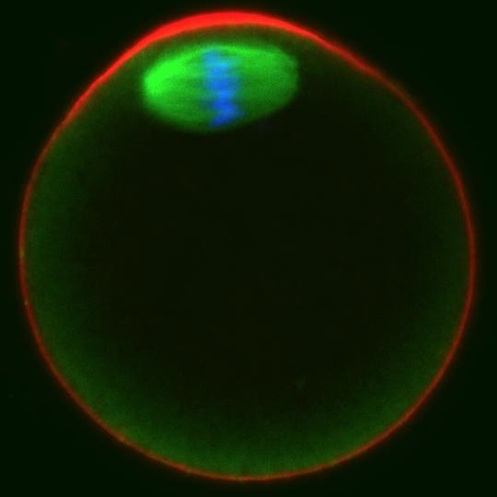Unlocking key to infertility in older women
Female fertility declines rapidly after the age of 37. Women over 42 have only a five per cent chance of having a baby without fertility treatment. New research may finally answer why older women have higher numbers of miscarriages and babies with chromosomal abnormalities.
The problem is that as a woman ages, her eggs also age — increasing chances of chromosomal abnormalities and an increase in conditions such as Down's syndrome, where the egg has three copies of chromosome 21. In women over 40, most miscarriages are caused by the wrong number of chromosomes being present in the egg. However most chromosomal abnormalities in eggs often lead to failure to implant in the uterine wall, or miscarriage soon after implanting.
In a paper published in Nature Communications, Professor John Carroll from the Monash Biomedicine Discovery Institute (BDI), together with University College London and an international team of collaborators, reveals a error in how an egg controls the levels of a protein called securin. In the final stages of egg development just before ovulation, the egg undergoes two specialized cell divisions known as meiosis I and meiosis II.
Securin is important in both meiosis I and meiosis II. But old eggs, appear to have an insufficient amount to ensure meiosis II takes place normally.
Most chromosome abnormalities occur in the first egg division (meiosis I) but it is known a substantial number of abnormalities also occur during meiosis II. Dr Ibtissem Nabti PhD (formerly from University College London, currently at the Division of Science, New York University Abu Dhabi, UAE) along with Professor Carroll's experiments help explain why things go wrong in the second division (meiosis II). In some older women, chromosomes in their eggs start to fall apart due to insufficient securin which controls the process.
Their discovery opens the way to improve an older woman's chances of having eggs with fewer chromosomal abnormalities by regulation of processes that control securin levels in the two divisions of the egg — or through the control of a protein called separase that securin regulates. Professor Carroll sees these new therapeutic approaches to improving egg quality as very important in this era when women are having their first baby increasing later in life.
"It is immensely challenging as any treatments need to be safe ... and would usually need to be applied while the egg is in the ovary. It may one day be possible to perform treatments in-vitro (in the laboratory) but human in-vitro egg maturation is not yet very successful. Now that we have an idea of at least one of the causes ...we can attempt to find ways to prevent this happening"
John Carroll PhD, Professor, Development and Stem Cells Program, Department of Anatomy and Developmental Biology, the Monash Biomedicine Discovery Institute, Monash University, Melbourne, Australia
The research team is working with Monash IVF to improve in-vitro maturation and identify new targets that may be able to better control prevent the degradation of Securin, according to Professor Carroll.
Infertility and Aging - Some Facts
• At birth, a woman has all the eggs she will ever have.
• As an egg ages it is more likely to develop a chromosomal abnormality.
• A fertilised egg with abnormal chromosomes is the single most common cause of miscarriage: at least half of all miscarriages are due to abnormal chromosomes.
• A woman in her 20s has only a 12-15 per cent chance of having a miscarriage each time she becomes pregnant. On the other hand, a woman in her 40s faces on average a 50 per cent risk of miscarriage.
Abstract
Sister chromatid attachment during meiosis II (MII) is maintained by securin-mediated inhibition of separase. In maternal ageing, oocytes show increased inter-sister kinetochore distance and premature sister chromatid separation (PSCS), suggesting aberrant separase activity. Here, we find that MII oocytes from aged mice have less securin than oocytes from young mice and that this reduction is mediated by increased destruction by the anaphase promoting complex/cyclosome (APC/C) during meiosis I (MI) exit. Inhibition of the spindle assembly checkpoint (SAC) kinase, Mps1, during MI exit in young oocytes replicates this phenotype. Further, over-expression of securin or Mps1 protects against the age-related increase in inter-sister kinetochore distance and PSCS. These findings show that maternal ageing compromises the oocyte SAC–APC/C axis leading to a decrease in securin that ultimately causes sister chromatid cohesion loss. Manipulating this axis and/or increasing securin may provide novel therapeutic approaches to alleviating the risk of oocyte aneuploidy in maternal ageing..
About the Monash Biomedicine Discovery Institute
Committed to making the discoveries that will relieve the future burden of disease, the newly established Monash Biomedicine Discovery Institute at Monash University brings together more than 120 internationally-renowned research teams. Our researchers are supported by world-class technology and infrastructure, and partner with industry, clinicians and researchers internationally to enhance lives through discovery..
Return to top of page
|



